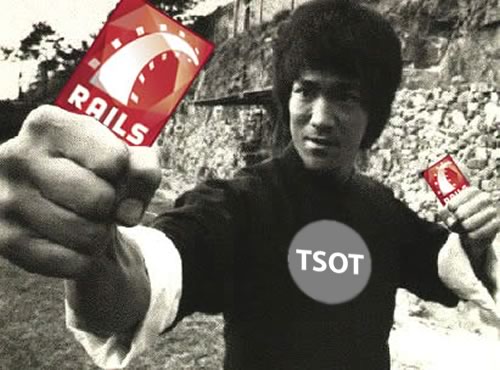
Don’t forget: TSOT’s first Ruby/Rails project night takes place next Tuesday! Admission is free, but space is limited, so sign up now!
The Quick Version
TSOT Ruby/Rails Night
Tuesday, January 8th, 2008 (and the second Tuesday of every month)
@ TSOT’s office — 151 Bloor Street West (on the south side, just east of Avenue Road)
11th floor
Door open and food at 5:30 p.m.
Presentations start at 6-ish
FREE ADMISSION (but limited space)
To register, please email joey.devilla@tsotinc.com
About TSOT
TSOT is a Toronto-based start-up that develops — look out, here come the buzzwords — social networking applications using Ruby on Rails. Our first applications are FraternityLive and SororityLive, social software built specifically for people in fraternities and sororities. Both apps are currently being tested with a userbase of thousands of university students and alumni, and we expect to release them in early 2008.
About Ruby/Rails Project Nights
We believe that it’s good for Toronto to have a healthy developer ecosystem — it’s good not only for us as a Toronto-based development shop, but also as a group of developers who are passionate about the work we do. We’d like to see Toronto as “Silicon Valley++” — with the vibrant high-tech scene, but with all the amenities that make Toronto a better place to live than the Valley (such as not being a dreary 50-mile stretch of suburbia and having decent places to go at night).
Hence our contribution to the local developer scene: TSOT Ruby/Rails Project Nights, which will take place on the second Tuesday of every month. They’ll feature in-depth presentations by developers working on interesting projects — primarily Ruby and Ruby on Rails — along with drinks and munchies and a chance to socialize with your fellow developers. They’ll be hosted by Yours Truly, TSOT developer and DemoCamp regular Joey “Accordion Guy” deVilla.
The First Night: Next Tuesday, January 8th
This first Ruby/Rails Night will feature presentations by a couple of Ruby/Rails local heroes on their current Ruby/Rails projects:
- Andrew Burke
- The developers from Unspace
- …and a quick presentation by Joey deVilla called “Do the Stupidest Thing That Could Possibly Work”.
The doors will open at 5:30, the first presentation will start at about 6, and we hope to wrap up the evening by 8:30 or 9. We’ll provide food and drinks, and if there’s enough of a demand, we can always go out to a nearby pub afterwards. There’s no cost to attend (but be advised that seating is limited).
If you’ve been thinking about making a Ruby or Rails presentation (perhaps you want to rehearse for RailsConf 2008!), we’d like to have you present it at one of our project nights!
Add TSOT Ruby/Rails Nights to your list of New Year’s resolutions!
How Do I Register?
Registration is free, but space is limited. To register for the upcoming Jan 8th gathering, please email joey.devilla@tsotinc.com
For More Information
For more information about TSOT Project Nights, please contact:
- Joey deVilla, Senior Developer (joey.devilla@tsotinc.com)
- Corina Newby, Public Relations Officer (corina.newby@tsotinc.com)
The event is also listed on Upcoming.org.
